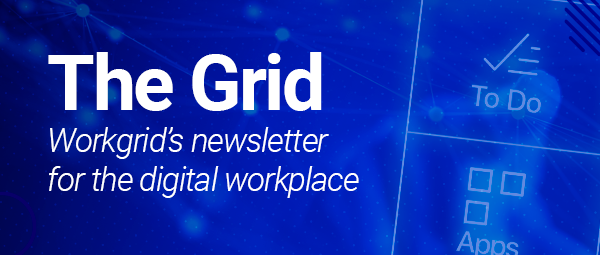What is an AI Assistant for Work?
An AI Assistant, sometimes referred to as an enterprise copilot, virtual assistant, or digital assistant, is technology that uses artificial intelligence to assist employees at work by processing simple tasks, surfacing information, and answering questions in the form of a natural language conversation.
With the help of AI technologies, these types of assistants are able to improve efficiency by leveraging generative and conversational AI alongside ranking algorithms and integrations to business systems. Employees can receive information from across their digital workplace directly through an AI Assistant and can typically take action from the same interface, such as completing an approval or submitting an IT ticket.
The AI Assistant for work is designed to drive significant value for employees across an organization regardless of department or role by helping to improve knowledge discovery, productivity, and IT operations. By bringing together information and actions from across the digital workplace, an AI Assistant for work can improve complicated workflows and processes for employees with the help of technologies such as natural language processing and machine learning to understand intent and deliver information to employees.
With integrations to common business systems, the AI Assistant reduces context switching and guides attention to the notifications, information, and actions that need to be addressed. This can cover a wide variety of use cases such as training reminders, expense approvals, sales opportunity updates, IT ticket updates, and more.
An intuitive, multi-channel interface means employees can access and utilize their AI Assistant across the digital workplace, from a company intranet or portal to Microsoft Teams, or as an intranet browser extension available across the web. With access across the digital workplace, an AI Assistant is an ever-present tool that supports employees directly within the flow of work.
How Does an AI Assistant Work?
An AI Assistant platform is traditionally powered by technologies such as Natural Language Processing (NLP) and Large Language Models (LLMS) that enable AI Assistants to understand and respond to queries in a natural human-like interaction. In some cases, these softwares also utilize Retrieval Augmented Generation (RAG) as a retrieval mechanism to search a vast database of documents, articles, or other data sources to find information related to the user’s query.
By using RAG, an AI Assistant can deliver answers in a consolidated format, reducing the time employees spend reviewing answers or searching for specific details through a long list of search results. Vector search converts query text data into vectors that capture the semantic meaning of words. The query is then augmented to enrich the LLM’s prompt with pertinent information to help ensure that its responses are accurate, insightful, and up to date. Once the information is retrieved, a generative model, often a variant of a transformer-based model (like OpenAI ChatGPT) synthesizes this information into a coherent, human-like response.
In contrast to the traditional employee chatbot, an AI Assistant can be considered conversational AI. Unlike the traditional chat experience which relies on manual configuration and basic logic reasoning to respond to user input, conversational AI Assistants have the ability to provide more proactive assistance. Conversational AI continuously learns from interactions, allowing it to improve over time and handle multi-turn requests.
![[gif] nexthink-free-up-space](http://images.ctfassets.net/z7p73u8c0thn/366SwRKb9GBkvtvwJHaxH0/339a7e9bfd227d3a0d541c8cfe7dae28/nexthink-slow-free-up-space.gif)
Benefits of AI Assistants at Work
Implementing an AI Assistant for your employees may bring numerous benefits to the workforce. Depending on what solution you choose and the features that you leverage, you can expect to see some of the following benefits.
1. Boost Workplace Productivity
AI Assistants, sometimes called Enterprise Copilots, enhance efficiency at work by streamlining repetitive tasks. With the help of automation, employees can more quickly complete tasks which allows more time to focus on high value work.
![[asset] 2023-Homepage-Switchback-Expense](https://images.ctfassets.net/z7p73u8c0thn/7rmeFfOquC6NlHm3sL28xS/4b2b857e889e9e4db07ee4057081a36e/2023-Homepage-Switchback-Expense.png?w=1200&h=879&q=60&fm=png&bg=transparent)
2. Cost Savings
By infusing an AI Assistant into the digital workplace, employees are able to find and access information in a more intuitive manner. An AI Assistant not only reduces the need for costly help desk tickets, it also delivers cost savings by helping employees make faster and more accurate decisions with improved access to data and information.
You may be thinking, but integrating an AI Assistant with the digital workplace will require expensive development resources. Look for AI solutions that have pre-built integrations with business systems and meaningful development experiences like a low-code builder. These limit costly development for building custom apps and make time to value even faster.
Additionally, a system agnostic digital assistant maximizes value for organization by delivering a solution that can provide benefits across the business rather than in siloes across specific departments or job roles. Save time, money, and increase your return on investment with a solution that meets a wide range of employee needs.
![[asset] intranet-chatbot](https://images.ctfassets.net/z7p73u8c0thn/1IXVpNXdd8vJ8ZeFM5gEvw/18c35f8466648e73b01b436b7798d157/conversational-ai-knowledge-management.png?w=1200&h=1061&q=60&fm=png&bg=transparent)
3. Enhancing Employee Experience
An AI Assistant offers prompt, 24/7 support to employees whether they need to find information or complete a task. These modern, intuitive interactions with business systems reduce digital friction and frustrating context switching, making it easier for employees to focus on high value work.
![[asset] systems-alerts-and-notifications](https://images.ctfassets.net/z7p73u8c0thn/6IIKbODFh4CF6W386Eu0kJ/4d1b8b08eb8ba58ed81d755b4820ca7e/system-alerts-and-notifications.png?w=1200&h=1200&q=60&fm=png&bg=transparent)
Exploring AI Assistant Use Cases
AI Assistants for Enterprise Productivity
By investing in an AI Assistant, you are investing in enterprise productivity at a high level. With a variety of use cases that streamline and automate workflows, an enterprise copilot can delight employees across an organization. Here are a few examples:
Approvals – Reduce cluttered email inboxes and clunky login experiences. Streamline approvals such as expense, procurement, promotion, timesheet, and more with an AI Assistant. Deliver system-based approvals in a consolidated notification stream where employees can easily review and approve or deny a request.
Knowledge Discovery – Find information quickly by asking the Assistant questions. Responses can be aggregated from across a variety of sources including uploaded documents such as the employee handbook, knowledge repositories such as ServiceNow, and system data.
Office Productivity Agent – A more advanced implementation includes agentic AI which can help employees complete multi-step processes. In the case of office productivity, employees could use an AI Agent to improve daily workflows such as drafting an email to their team, blocking off the calendar for focus time, or summarizing unread emails.
AI Assistants for HR
For human resources, an AI Assistant for work offers use cases that support employees from their first day to their last.
Onboarding – Automate workflows to help new hires feel welcomed, connected, and engaged with supporting resources delivered to employees through an Assistant across a specified cadence.
Training Reminders & Notifications – Foster a culture of inclusion and growth with streamlined training notifications and reminders. Notify employees when they have an upcoming or overdue training, guiding their attention to your existing learning management system. Plus, keep managers in the know with targeted notifications when a training request needs approval or an employee has registered or completed training.
Streamlined Access to Information – Make it easier than ever for employees to find information they care about such as policies, time off balances, and their latest payslip. With integrations to business systems and knowledge repositories, employees can surface data within the flow of work by simply asking questions like, “What is my time off balance?” and receiving a response through their AI Assistant, reducing the friction and time spent logging into systems. With employees able to find information through self-service, HR staff can spend time on more high value tasks that need their attention.
AI Assistants for IT
Reimagine IT operations with the implementation of an AI Assistant. Whether you’re looking to bring controlled generative AI to employees or to streamline incident management, an AI Assistant can get you closer to your goals.
IT Help Desk & Incident Management – By making complicated and time-consuming actions easier and quicker to complete, an AI Assistant can streamline IT ticket case management and reduce costs. Using a conversational interface, employees can create and submit tickets right through an AI Assistant, as well as receive notifications when there is a change, comment, or ticket closure so they can easily manage their case and ensure they are always up-to-date.
Genie Apps – Deliver generative AI to employees in a controlled environment that reduces the risks associated with shadow AI while also giving employees access to this powerful technology. By delivering generative AI through an assistant, IT teams can ensure safe and professional output while giving employees the ability to generate content, insights, and summaries for business use.
Automating IT Requests - Help employees complete an array of requests and get instant access to what they need, from ordering equipment to updating an email distribution list. Through an AI Assistant, employees are directly connected with IT systems such as ServiceNow, Zendesk, Jira, and more, eliminating the need to log in to each individual system. This reduces the number of steps required to take action and allows tasks to be completed seamlessly within the flow of work.
Implementing an AI Assistant
Finding the best AI Assistant for your organization can take some time. You might be considering a few variables such as buying an off-the-shelf solution or building in-house. Or perhaps you’re not sure yet what use cases would add value to your employees’ challenges. Either way, as you embark on your journey looking for the best AI Assistant, the team at Workgrid is available to help you explore your options. A member of our team would be happy to provide a personalized product tour and answer any questions you may have.
AI Assistant for Work Case Studies
Looking for inspiration? Explore how other organizations improved the employee experience, knowledge discovery, and productivity with an AI Assistant for work:




